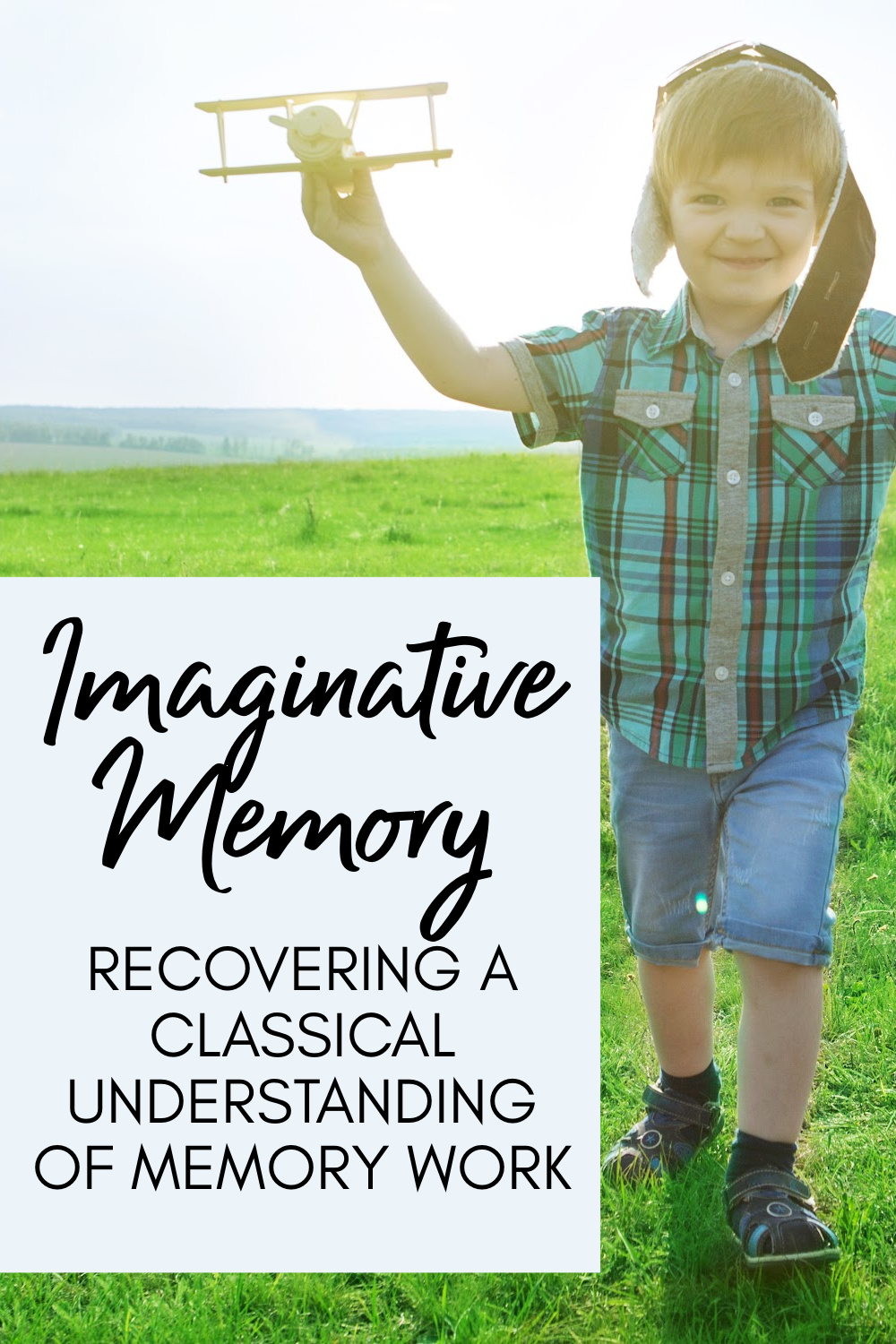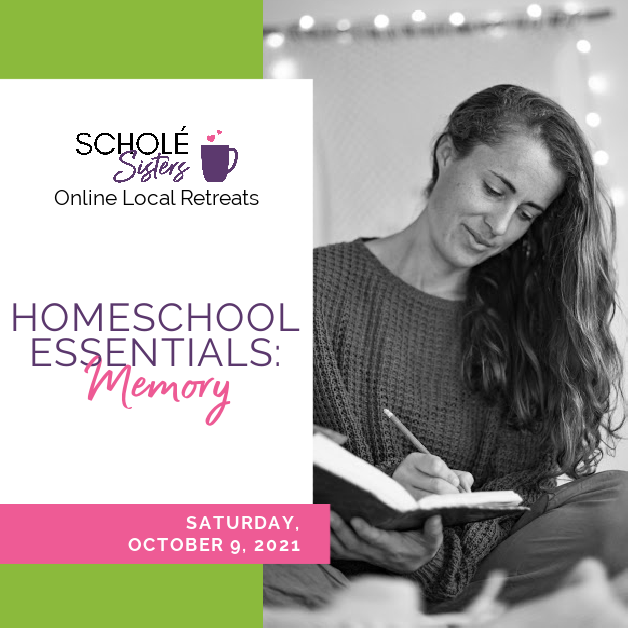Imaginative Memory
Mystie wrote this paper in Spring 2021 for her History of Classical Education graduate class at New St. Andrews college. Slight format changes have been made for publication here.
In khaki shorts and skirts with color-coordinated polos, 5-year-olds stand in front of parents, grandparents, prospective school families, and potential benefactors. Rattling off lists of states with their capitals, history events, and presidents, the students’ accomplishments prove the efficacy of classical education.
That, anyway, is the reasoning for both doing the memory work and showing off the memory.
Across town, a mother quizzes her 6-year-old in front of her in-laws. The situation is different, but the purpose the same. The amount of information the 6-year-old can repeat demonstrates to the skeptic that education is happening, that homeschooling is valid and viable.
A young child who can nimbly articulate all manner of facts is indeed delightful, but is such a one a paragon of classical education? It is indeed true that classical education – from Cicero and Quintilian in the classical era itself to the revival of the tradition today – has prioritized memory development, especially for young students.
Dorothy Sayers’ essay, “The Lost Tools of Learning,” inspiring a movement of education revival, attempts to return wayward moderns to old, memory-laden paths. However, as we continue to recover and revive an education rooted in classical and Christian ideals, we must be sure we not only understand what Sayers herself was saying about memory work, but also what the tradition reveals about historic practice.
When aligned with Quintilian, Hugh of St. Victor, and Comenius, Sayers’ insights about memory work are illuminated and clarified in unexpected ways.
In her famous essay, Sayers shares four key observations about memory. First, she says students should practice recitation aloud, individually and as a group, “for we must not forget that we are laying the groundwork for disputation and rhetoric.” Memory as preparation for public speaking is in keeping with Quintilian’s vision of educating the orator who can not only articulate and enunciate correctly, but who also delivers a speech with grace.
Second, Sayers advises that the students’ memories be stocked with a clear historical timeline not only of their own country but also of God’s salvation history. Hugh of St. Victor also began his students with knowledge of history, desiring young students to know names and dates and events before studying the liberal arts directly.
Third, Sayers recommends that memory work be tied to visual and imaginative content, not merely sounds of syllables. In this she concurs with Comenius, who laid down the principle: “as far as possible, instruction should be given through the senses, that it may be retained in the memory with less effort.” Finally and perhaps most famously, Sayers recommends focusing on filling the memory of young students before serious studies begin, during what she calls the “Poll-parrot stage,” which extends from the time a child can read and write until they are around 11 or 12.
Quintilian, Hugh of St. Victor, and Comenius all share her observation that memory is natural and strong at this age as well as her application that it ought to be the primary element of education during this time. Thus, in several of her key ideas about memory, Sayers is indeed faithful to historic sources.
Few classical sources are cited more by medieval and renaissance educators than Quintilian, so it is reassuring to find echoes of Quintilian in Sayers’ thoughts on education as well. Quintilian’s goal in educating was developing an orator, so his purpose and methods for memory work were tailored to achieve that end. Because memory is most retentive in the young, Quintilian argues, they should be taught to read and write because both skills are “entirely a matter of memory.”
Sayers shares this emphasis when she says that the strong memories of the young should be harnessed to learn not only their native tongue, but also Latin and a contemporary foreign language. However, memory, in Quintilian’s view, is not a stage or phase any orator ever outgrows. In fact, memory is such an integral part of rhetoric that it is one of the canons.
As he put it, memory is the “common guardian” of all the canons of rhetoric, providing safekeeping for knowledge and skill. Quintilian also has a use for memory far beyond sheer fact recitation. His valuation of memory is larger than storing particular words away; it includes what might now be called muscle memory training as well: “Force him to learn select passages by heart and repeat them standing, clearly and in the way he will one day have to plead.”
Thus, into his memory is stored not merely the words, but the stance and style proper for delivery as well. Sayers agrees that memory work is a foundation for future rhetorical use, and her primary call to action for educators is to make a “progressive retrogression” to medieval systems of education; although Quintilian is not medieval, medieval educators relied upon his wisdom, so we also should study and reclaim Quintilian’s use and methods for memory as we recover the education Sayers alerts us to.
Again and again, Sayers calls her audience to the medieval scholastic vision of education; none presents that scheme more systematically and clearly than Hugh of St. Victor. For Hugh, education is about forming wisdom, which requires friendship with Christ, who is Himself Wisdom. Memory training begins the path of learning that ends in wisdom and eloquence.
Though his Didascalicon is silent on the age of the students he intends, “The Three Best Memory Aids for Learning History” on learning history via an elaborate memory palace is clearly addressed to children. Ivan Illich confirms that Hugh’s intent was “that young beginners move with ease.” Their imaginative treasuries full of knowledge prepared them for meditative reading; thus he extended the application of classical memory palace techniques beyond public speaking to personal reading and thinking.
According to Illich, “Hugh not only revives the old art of memorization but radically transforms it by placing it in the service of historia.” Hugh’s direction to “diligently commit to memory the truth of the deeds that have been performed” in history corresponds with Sayers’ thoughts on memorizing dates and God’s revealed historical narrative, but his attitude and hers are worlds apart.
Nowhere in Hugh is there a sense that “it does not greatly matter which dates.” His goal for memory was not to impress anyone with the ability to rattle off names and dates, but rather to have the tools of wisdom and understanding instantly available within one’s own mind so as not to be hampered by the need to look up formulae or basic truths.
Although Sayers comments that children enjoy an “attractive jingle” or “resounding polysyllables,” and although she does make the offhand comment that the dates memorized do “not greatly matter,” yet she also says to memorize what “can usefully be committed to memory.” Her overall goal and project must be kept in view: “to teach men how to learn for themselves.” Both Hugh and Sayers cultivate memory to give students the tools of learning, not to store up a huge collection of trivia.
Though at first it appears he recommends merely memorizing of a timeline with names, dates, and places as is done today by those following Sayers’ model, Hugh’s program is not one of a few historical or informational pegs but of an entire mental, imaginatively-engaged framework for salvation history within which students perform feats of intellectual acrobatics.
Illich refers to Hugh’s “mnemotechnics” as a “way of imagining” not only the world but all of history and the world. A vision for memory as the ability simply to store away and reproduce verbatim series of random data points is inadequate to the scholastic tradition Sayers tells us to emulate; it is being satisfied with far too small a repayment on the effort than these worthy educators were aiming at. Whereas today the skill of memory is counted merely as being able to recall and repeat words verbatim, rote repetition alone would not have been proof to the medieval schoolmaster that memory had been achieved.
As historian Mary Caruthers notes, modern psychology has led us to exclude “from [memory’s] concerns the ability to reconstruct such information, whether logically or by a mnemonic scheme.” The medieval, on the other hand, thought of memory as recollection, the ability to hunt out of the treasure-stores of the mind associations and knowledge. Caruthers goes further, stating, “Rote repetition, since it is not ‘found out’ by any heuristic scheme, is not considered recollection or true memory.”
The true heart of Sayers’ essay is to turn back the pages of history and do, as far as we are able, what the scholastics were doing in education; Hugh’s program, therefore, is an important piece that ought to inform our grammar schools.
Sayers shares with John Amos Comenius a commitment to a noble, generous education offered not only to the elite but to all. For both of them, that generous education must include a strong memory program. Like Sayers, Comenius believed young students should develop their memory.
The young, notes Comenius, have a “tenacious” memory that must be harnessed and cultivated while his mind is still “quite wet and soft and fit for receiving all images that come to it.” According to Comenius, the training of the capacity for memory aligns with nature, for “Nature prepares the material before she begins to give it form.” Youth, he says, is the best time to dedicate to education for then the mind is “fresh and gathering strength; then everything is vigorous and strikes root deeply.”
As he unfolds his educational methodology, he ties memory and sense perception together closely, claiming that “as far as is possible, instruction should be given through the senses, that it may be retained in the memory with less effort.” Sayers also makes this claim, though it is easy to overlook; she says the historical dates should be learned “provided that they are accompanied by pictures of costume, architecture, and all ‘every-day things,’ so that the mere mention of a date calls up a strong visual presentment of a whole period.”
Though sing-song chants and flashcards have been a go-to application of Sayer’s emphasis on memory, her comments indicate a more elaborate and imaginative undertaking. Rather than take her essay as the outline for our own educational efforts, we should heed her overarching advice to return to the laid-out programs of the past like that of Comenius.
Unlike Sayers, Comenius stressed a memory program integrally tied to understanding: “For that only which has been thoroughly understood and committed to memory as well, can be called the property of the mind.”
Memory, according to Comenius, is the stem of knowledge which bears the fruit of an ease with language and practical, productive skills. However, if memory is the stem, then its roots must be tended and strong: “the educator of the young [should] give special attention to the roots of knowledge, the understanding, [which] will soon impart their vitality to the stem, that is, to the memory.”
The idea Sayers propounds, that information can be memorized and known without being understood, appears at first to flatly contradict Comenius. However, letting the author interpret herself, the context reveals that by “understand” she’s likely referring to an ability to give “rational explanations” and display a “power to analyze” when the developmentally appropriate form of knowing for the young ought rather to rely on “a strong imaginative appeal.”
On this point Comenius and Sayers are closer than first glance would indicate, for both are insistent that the presentation and requirements of education fit a natural progression of ability and development. Thus, a closer reading of Sayer’s overall message pushes us to rethink our approach to memory in the young years.
Sayers’ name of “Poll-Parrot” for the early stage of education, combined with her remark that understanding is optional, has led to an application of memory work unknown to the historic sources Sayers desires us to emulate.
A parrot mindlessly repeats his betters, and, what is more, his repetition gets him nowhere. For the sake of catchiness, Sayers sacrificed clarity. Classical Conversations summarizes their application of Sayers’ model as “a grammar student is chiefly absorbed in memorizing the rudimentary facts and principles of any subject.” Although Sayers spends nearly twice as much space in her essay emphasizing that grammar students learn languages than learn facts of different subjects, practitioners today emphasize the facts of subjects rather than the language acquisition Sayers identified as the main activity.
Where are the classical educators today with grammar students fluent in three languages? Acquiring multilingual reading and speaking fluency before going on to studying the liberal arts is in keeping with the tradition found in Quintilian, Hugh of St. Victor, and Comenius. Emphasizing a gathering of an assortment of facts is not. In fact, Hugh, from the scholastic tradition Sayers most desired to revive, states, “Surely the more you collect superfluous details the less you are able to grasp or to retain useful matters.”
A careful reader ought to note that Sayers couldn’t be proposing a program of memorizing the facts of subjects because the whole concept of a school “subject” was part of what she was attacking. Rather than memorizing lists and definitions, the medievals conceived of memory as “a storehouse of inventoried topics that ideally would contain all previous ways-of-saying ethical truths like ‘justice.’” Because she was advocating for a return to an old way, we ought to examine the meaning of vital topics like memory to ancient and medieval educators rather than assume our common usage today is adequate.
Another aspect in which Sayers’ essay is inadequate to setting forth an education methodology is in regard to how to exercise and fill our students’ memory. Her use of the words “chanting” and “jingle” are found in claims of what children enjoy naturally and not what teachers should do nor as the best memory techniques. In her essay, Sayers does not actually give a method for teaching.
Again, rather than take Sayers’ comments as more than they were meant to be, we should follow her advice of returning to the priorities and practices of the memory masters: classicists like Quintilian, scholastics like Hugh of St. Victor, and education reformers like Comenius, each of whom open new realms – or, more truly, old realms – of memory methodology.
To learn a thing “by heart,” Quintilian notes that “students of any age who are concerned to improve their memory by study should be willing to swallow the initially wearisome business of repeating over and over again what they have written or read,” even “as it were chewing over the same old food.” From children, Quintilian insists on word-perfect recitation without any visual or verbal prompting to accustom them to accuracy and mental discipline.
Memory is an art gained through “practice and effort,” but the practice can come in a variety of forms. Quintilian advises assigning symbols to written sections being memorized so that the imagination is engaged as a prompter to the next section. Even simply memorizing from the same written copy of a work ties the mind and the eye together so a stronger connection is made and “when he speaks, he is almost in the position of a person reading aloud” because his mind’s eye is following the page he had so many times repeated.
Sayers says that the purpose of memory is “as a gathering-together of material for use”; to accomplish gathering and memory, Hugh recommends the learner create his own outlines, summaries, abstracts, and narrations which are then to be regularly reviewed even after they are “stored in the little chest of the memory” so that they can be called forth easily when needed. Comenius brings traditional Latin wisdom back into play, recommending students not only write out and repeat material to fix it in the memory, but also teach it to others to fully imprint information on the mind.
Additionally, Comenius recommends having visual representations on the wall of the classroom to cue memory. Whatever prompts are used, he admonishes that it is constant review, constant rereading, that keeps memory retentive. The tradition of memory development exemplified in Quintilian, Hugh of St. Victor, and Comenius emphasizes the key role memory plays in the efficacy of learning itself. Memory is always at play when true learning takes place, which is why all educators should be sure the capacity is expanded and exercised.
Sayers never intended her essay to be the basis of a full school program, as she makes clear at the outset; we are following Sayers’ truest and best insight when we take her advice to look to the past and appropriate for today their aims and methods. Quintilian, Hugh of St. Victor, and Comenius provide rich and nuanced concepts and frameworks for developing memory in meaningful ways with students.
Although no single author lays out a complete scope and sequence with orthodox methodology we can fully implement today, even for such a seemingly simple and obvious practice as memory work, we can still learn and apply the principles of memory they make clear, deepening and enriching our current practices. The goal of memory work is not to insert the coin or give the command and have the proper product come out of the mouth. We are more truly aligning with Sayers herself when we listen to and apply ancient and medieval wisdom.
When our khaki-and-polo students can talk to one another not only in complete sentences within their mother tongue, but also in Latin and in a modern foreign language, then will their memories be trained to receive the liberal arts. When that homeschooled child and mother worry not what the grandparents think, but delight in adding new connections to their inner treasuries, then they will be applying memory for wisdom.
By enriching the purpose and practice of our memory work, we can avoid vain repetition and ensure strong habits of mind that lead to wisdom and eloquence.
“Without memory, there is no education.”
– Hugh of St. Victor
Spend a day with us, applying the classical art of memory in practical, inspiring ways to your homeschool.



